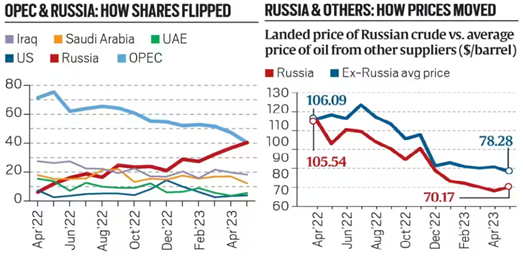Context
- Since the Russian invasion of Ukraine in February last year, India’s refiners have been buying up discounted Russian oil.
- Moscow has since leapfrogged to become India’s leading source of crude oil, accounting for about 40% of India’s crude imports. June marked the 10th consecutive month-on-month increase in India’s imports of Russian crude.
The Transformation of India’s Oil Trade with Russia
- According to the Directorate General of Commercial Intelligence and Statistics (DGCI&S), India’s oil imports from Russia have grown more than 10 times since April 2022.
- The growth has been steady especially since December 2022, after the G7 imposed a $60-per-barrel price cap on seaborne Russian crude.

Factors Led to the Growth in Indian Import of Russian Oil
- Western Sanctions on Russian Oil
- The EU stopped importing Russian coal and banned refined oil imports.
- The US and UK banned all Russian oil and gas imports.
- Germany stopped the opening of the Nordstream 2 gas pipelinefrom Russia.
- In December 2022, the EU and G7 set a maximum price of $60 a barrelfor Russian crude oil.
- Huge Discounts Offered by Russia
- Russia heavily relied on countries like India, China, Turkey, and Bulgaria for oil sales since the imposition of sanctions imposed by western nations.
- Russia offered huge discounts on crude oil to interested countries. India used the opportunity to its advantage.
The Mystery of Actual Discounts: Russia and Other Suppliers
- While Indian refiners have been buying cheap from Russia, the actual discounts on the oil remain mystery due to the opaque pricing of Russian oil cargoes.
- Indian refiners buy on a ‘delivered’ basis, which means that the price of the cargoes includes the cost of freight and insurance, apart from the cost of the oil itself.
- The best available marker for discounts is a comparison between the average landed price of Russian crude and the average price of oil imported from all other suppliers.
- Western sanctions have raised freight and insurance costs for Russian oil considerably.
- This suggests that discounts may be higher on the price of oil, and lower on the landed price (including freight and insurance costs).
Change in Market Shares of India’s Top Oil Suppliers in Recent Months
- Russia’s Gain at the Expense of other Suppliers
- A comparison between market shares (by volume) of India’s top 10 crude oil suppliers in the 14 months ended April 2023 and their shares in FY2021-22 shows Russia has gained at the expense of other suppliers.
- Russia’s market share surged to 24.2% in the 14-month period, up from a measly 2% in FY22.
- Most of the other major suppliers saw their market shares fall - Iraq, Nigeria, and the US saw the most notable declines.
- Decline in OPEC’s Share in India’s Oil Imports
- The cumulative market share of members of the Organization of the Petroleum Exporting Countries (OPEC), the major oil producers’ group that dominated India’s oil import basket, declined dramatically as India’s Russian oil imports graph rose sharply.
- OPEC’s share in India’s oil imports fell by almost half — from 75.3% in May 2022 to 40.3% in May 2023.
- Among the major suppliers to India, Iraq, Saudi Arabia, the UAE, Kuwait, Nigeria, and Angola are members of the OPEC cartel.
- During the April 2022-May 2023 period, Russia’s share in India’s oil imports zoomed from 6% to 40.4%.
How has India Benefitted from Discounted Russian Oil?
- Significant Savings by Indian Refiners
- Indian refiners saved at least $7.17 billion in foreign exchange in the 14 months ended May 2023 by ramping up buying of discounted Russian oil.
- India imported $186.45 billion worth of oil between April 2022 and May 2023; the total amount would have been $193.62 billion had Indian refiners paid the average price for crude from all other suppliers combined.
- Emergence of India as a Major Supplier of Refined Petroleum Products
- India has emerged as a major supplier of petrol and diesel -- some of it refined from Russian crude -- to Europe and elsewhere.
- India's petroleum product exports to the EUrose 20.4 percent year on year between April and January to 11.6 million tonnes, which has led to Indian refiners enjoy "robust margins".
Emerging Challenge for India in Russian Oil Import
- Volatile Discount Levels
- The discount levels of Russian oil shot up initially (in May 2022) and contracted substantially in June, before rising again and stabilising for the next four months.
- According to industry sources, discounts have eroded considerably over the past few weeks, and Russia’s flagship crude has breached the G7 price cap.
- The discounts on Russian crude have reduced to just $4 per barrel from the peak 25-30$ per barrel.
- If this situation persists, oil from Russia may become a lot less attractive for Indian refiners in the coming months.
- Payment Woes for India Refiners
- Indian refiners are also facing problems in making payments for Russian cargoes due to western sanctions.
- The Indian Oil Corp recently had to make payments in Yuan because of shipping problems as the SBI refused to furnish payment due to sanction on shipping agency.
Conclusion
- India has resisted Western pressure to freeze out Russia, opting instead to strengthen trade ties with its long-standing ally with the added benefits of tempering inflation while saving money.
- However, with Russian discounts narrowing, Indian refiners may be forced to ramp up supplies from other sources.










